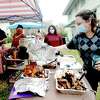It only took one press conference to kill any hopes Disney had of convincing the public that its American history theme park was a good idea.
When then-Senior Vice President Bob Weis took the stage for the official 1993 announcement of Disney's America, he was blunt.
"This is not a Pollyanna view of America … We want to make you feel what it was like to be a slave or what it was like to escape through the Underground Railroad,” Weis said.
Disney CEO Michael Eisner didn't do much better in his comments. “We are going to be sensitive, but we will not be showing the absolute propaganda of the country,” Eisner said. He promised the park would include “painful, disturbing and agonizing” exhibits about slavery and Native Americans.
In an article published the day after the disastrous press conference, the Washington Post wrote, “Disney officials said the aim of the project … is to present the controversies and conflicts of the nation’s history in a way not likely to offend visitors.”
It was already too late for that.
---
Disney’s had many big swings. It's had many bad ideas. But none were quite as big or as bad as Disney's America.
The idea began taking serious form in 1992, when Eisner and other Disney executives scouted the nation for a place to put an America-themed park. It didn't take long to settle on Haymarket, Virginia, a small town 5 miles from where nearly 4,000 men died in the first and second battles of Bull Run. For Disney's purposes, the location was perfect — just 35 miles from Washington, D.C., a tourist hub filled with people already seeking out U.S. history.
Still reeling from the financial disaster that was Euro Disney, this park was to be much smaller. Disney projected 6 million visitors a year (for reference, Disneyland saw more than 10 million visitors in 1994), many of them day-trippers from D.C. It would have nine lands, unsettlingly referred to as “territories.” They were:
Native America: A recreation of a Native American village, with a Lewis and Clark-themed river rapids ride
Presidents’ Square: The home of the park’s version of the Hall of Presidents attraction
Crossroads USA: The central hub of Disney’s America, from which guests could enter the other territories
Civil War Fort: A Civil War camp, complete with re-enactments and a nightly fireworks show on “Freedom Bay” featuring the battle between the Monitor and Merrimack
Enterprise: An homage to the Industrial Revolution in the form of a factory’s company town, complete with a roller coaster
We the People: A showcase building resembling Ellis Island with food vendors representing the countries of origin for immigrant groups
State Fair: A classic state fair with a wooden roller coaster, Ferris wheel and baseball diamond for exhibition games
Family Farm: A tribute to America’s farms, with exhibits on harvesting crops and taking care of livestock
Victory Field: A hangar with exhibits and rides celebrating American aircraft, including their role in World War II
Anyone who has been to Disneyland would have reasonable fears about the company's ability to create accurate, contextual historical entertainment. Main Street USA is a fantasy version of small-town life that never really existed, and Frontierland is an archaic cowboys-and-Indians caricature of American expansionism. So when Disney's America was announced, outcry was swift and pointed.
"Can the meaning of the Civil War be conveyed next to a roller coaster? Once a visitor has seen the Disney version of Ellis Island, will the real thing retain its appeal? Can slavery be properly interpreted in an amusement park?" National Trust for Historic Preservation President Richard Moe asked in a December 1993 op-ed.
The nation’s most famous historians, including Shelby Foote, James McPherson and David McCullough, formed Protect Historic America. The coalition of academics aimed to stop the construction of the park, not only because of concerns about historical accuracy but because of its proximity to hallowed Civil War battlegrounds. There were even concerns about the project’s name; Disney’s America seemed to imply Disney, in fact, owned America. The press took to calling it the “Third Battle of Bull Run.”
The blowback shocked and deeply rankled Eisner. His reign as Disney's chief executive was marked by incredible creativity, wild — at times reckless — expansion efforts, and blind spots big enough to lose a tank in. Disney's America was one of his most detrimental blind spots. Eisner, even by his own admission, repeatedly failed to see or understand why people would find a theme park version of history problematic.
In his 1998 book "Work in Progress," Eisner recalled taking a group of skeptical historians to Disney World to assuage their fears about Disney's America. He first brought them to The American Adventure, a 30-minute attraction where animatronic Ben Franklin and Mark Twain narrate guests through an overview of American history. It is a highly Anglo-centric retelling, and it didn't impress the academics. Eisner wrote that as they left the attraction, he realized they thought “Disney couldn’t be trusted to depict American history in ways that were sufficiently complex, subtle and inclusive."
“I was surprised by the intensity of their reaction," he wrote, "but not upset by it.”
He would soon become upset, his frustration apparent in interviews. "We have the right to do it. It's private land," he said in a June 1994 interview with the Washington Post.
"If people think we will back off,” he added, “they are mistaken.”
That month, a Senate subcommittee on public lands convened a hearing about the proposed park. Historians testified against it, and Disney officials advocated for it. It was a stalemate, leading to little beyond one of the most insane quotes ever uttered in a congressional hearing.
“I don’t know whether Mickey was a Confederate or whether he was a member of the Union forces,” declared Sen. Larry Craig, R-Idaho. “But I am willing to allow Disney the opportunity under proper local zoning and state authority to make a determination of whether Mickey should be wearing blue or gray.”
---
Almost certainly for the best, the answer to that question remains lost to time. A few months later, overwhelmed by the barrage of negative publicity and worried about the financial outlook — analysis revealed the park would likely need to close four months a year due to inclement weather — Disney killed the Virginia park in September 1994. Although at the time they said the concept wasn’t dead, Disney’s America was never again seriously revived. In the end, Disney finally realized melding its Mickey Mouse fantasy with the hard, brutal truths of American history was just a terrible, unworkable idea.
As is the case with many abandoned Disney projects, however, some components of Disney's America were eventually realized in other forms. Three of the scrapped park's rides made the cut for California Adventure, which opened in 2001. The Lewis and Clark river rapids experience became Grizzly River Run, the World War II area became Soarin' and Condor Flats, and the state fair concept was transposed to Paradise Pier.
The most forgettable piece of Disney's America was also revived for California Adventure: the working farm. That concept turned into Bountiful Valley Farm (sponsored by Caterpillar), which was basically a glorified community garden with a few tractors to climb on. Without much fanfare, it closed forever in 2010 to make way for Cars Land, proving that some ideas are simply bad, no matter where you put them.




















